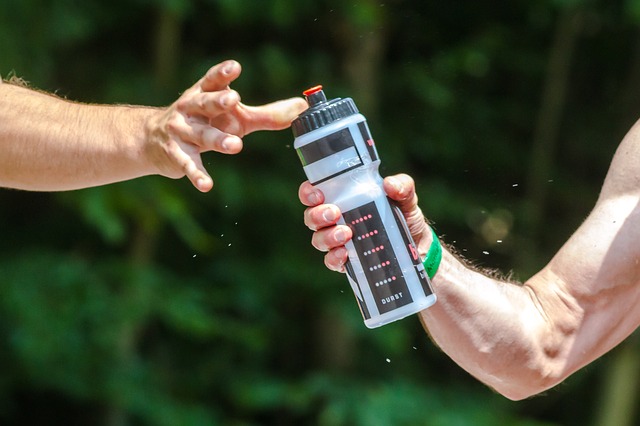Last updated on February 9th, 2023 at 04:42 pm

For reducing weight lifting muscle soreness, there’s a practice to drink a protein shake after a session of resistance exercises like heavyweights at the gym. But do you think it is fulfilling the very purpose?
A new study from the United Kingdom’s University of Lincoln puts a question mark on the purpose of the popular practice after any resistance exercises.
The first of kind study, which was published in the Journal of Human Kinetics, compare the effectiveness of both whey hydrolysate and milk-based drinks on the recovery of muscle function following acute resistance exercise.
In this article, we will try to understand how this unique study was carried out, its research methodology and how scientists came to this conclusion.
weight lifting muscle soreness
Researchers have shown that acute bouts of intensive resistance exercise result in transient muscle soreness and decrements in various aspects of athletic muscle function such as jump height, force production, and upper-body power-producing ability.
It is different from DOMS, delayed onset of muscle soreness.
It is a common practice for athletes to ingest supplemental drinks containing a mixture of protein and carbohydrates following exercise. Two protein sources that are commonly used in such drinks are milk protein and whey protein hydrolysate.
But, this new research has a different story to say.
Research methodology
Thirty male university population were recruited with at least one year of resistance training experience with a mean age of 25 years, body mass 80 kg, body height: 1.77 m.
Participants were evenly and randomly assigned to one of the three groups:
- Whey hydrolysate-based drink (WH),
- Milk-based drink (MB),
- Flavored dextrose /carbohydrate (CHO).
All drink that was served were prepared and provided in black water bottles and were administered by team unknown to participants, hence the double-blind design.
The volume of all drinks consumed was 900 ml each following mixing the powders with water. Following administration 10 min post-exercise, participants consumed their drink within a 10 min period.
Resistance exercise session
The resistance exercise session consisted of a series of multi-joint exercises.
- Squat
- Bench press
- Deadlift
- Military press
- Bench pull
Each exercise was performed for 4 sets of 8 repetitions, with 2-min rest intervals allocated between each set. Upon completion of the session, participants remained seated for 10 min before being administered with their respective supplemental drinks.
Procedures
Throughout their involvement, participants maintained their normal daily lifestyle and diet. Participants were asked to abstain from strenuous exercise 48 h before baseline testing and arrive at the laboratory in a hydrated state. Participants were advised to abstain from nutritional supplements for the duration of the study protocol.
They were provided with a diet and activity diary and were asked to replicate their diet and activity from the day before baseline testing.
Baseline testing session
During the baseline testing session, body mass and height were measured.
Step one: Participants were assigned to complete a total of five bodyweight squats. They were given the visual analog scale to transcribe their perceived levels of muscular soreness whilst executing the squats.
Step two: Each participant then completed a 5-min warm-up on a cycle ergometer, followed by three individual countermovement jumps (CMJ) and seated medicine ball throws (MBT).
Step three: Then they carried out a further 5-min warm-up on the cycle ergometer prior to isokinetic assessment. The isokinetic assessment included completing five maximal-effort knee flexion and extension actions using the dominant-leg after two warm-up sets, which completed the protocol of assessments.
Step four: Participants then completed three sessions on three consecutive days, beginning with the resistance exercise session and subsequent ingestion of the experimental supplemental drink, after this two further follow-up testing sessions, identical to baseline testing, were performed at 24 h and 48 h post resistance exercise session, respectively.
Also read: Quickly achieve weight loss goal by restricted eating
Result
At the start of the study, all participants rated their muscle soreness between 19 and 26, or quite low. Then, they reassessed those measurements 24 and 48 hours after the weight-lifting session. All participants rated their soreness above 90, which is quite high.
In the physical assessments, the participants showed reductions in muscle power and function.
However, there was no difference in recovery response and soreness scores between the three different groups. That means, the study’s authors concluded, that there is no additional benefit in consuming protein shakes or drinks for the sake of muscle recovery.
Source:
- Effectiveness of Whey Protein Hydrolysate and Milk-Based Formulated Drinks on Recovery of Strength and Power Following Acute Resistance Exercise: Published online: 21 Aug 2019: https://doi.org/10.2478/hukin-2019-0066
The author is a physiotherapist who has been practising for the last 17 years. He holds a Bachelor's in Physiotherapy (BPT) from SVNIRTAR (Swami Vivekananda National Institute of Rehabilitation and Research), one of the prestigious physiotherapy schools in India.
Whatever he learns dealing with his patient, he shares it with the world through blogs and e-books. He also owns a YouTube channel, "Sunit Physiotherapist" with over 8 lakh active subscribers. Here, he shares everything he gets to learn serving the patient.





